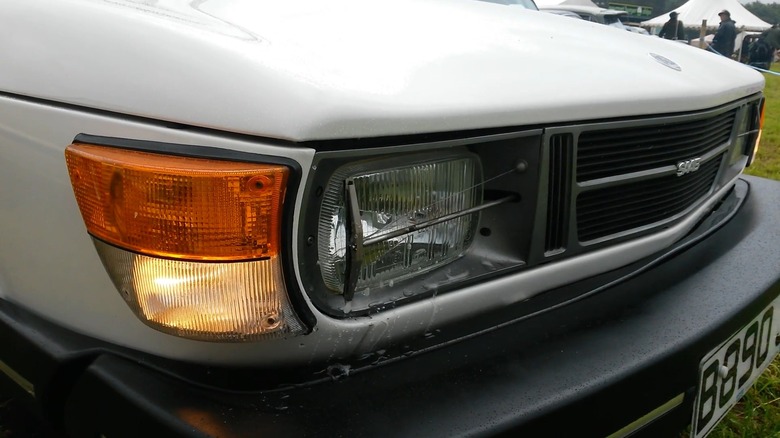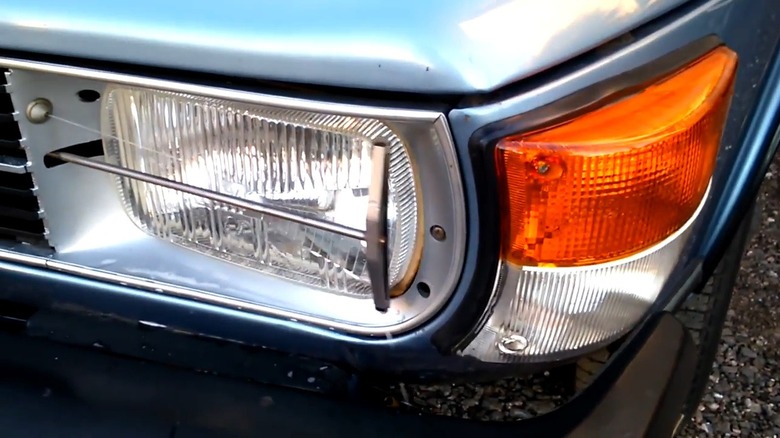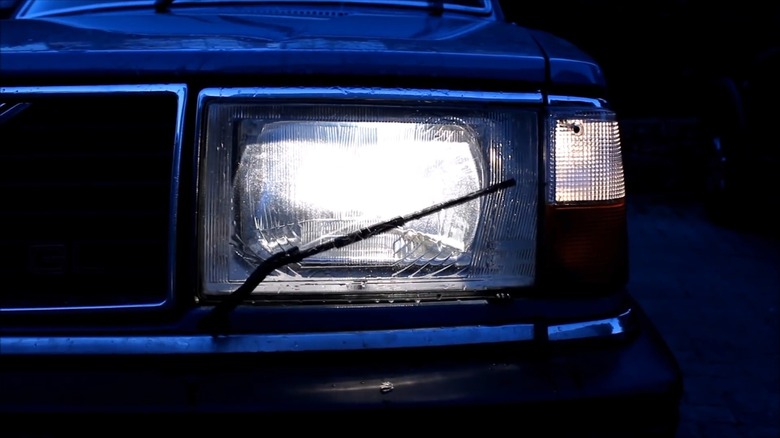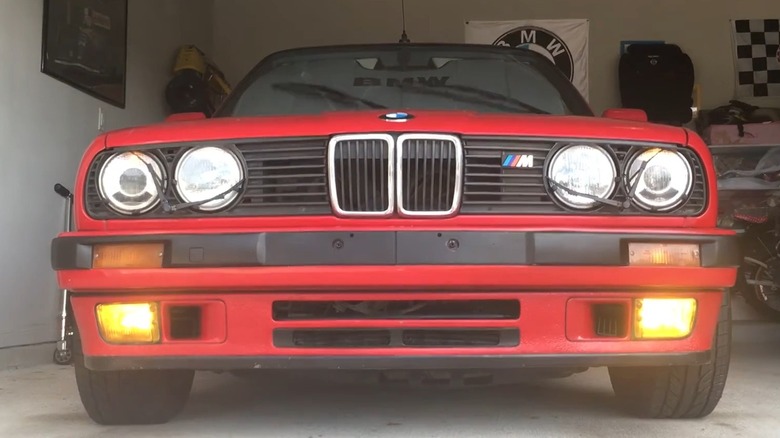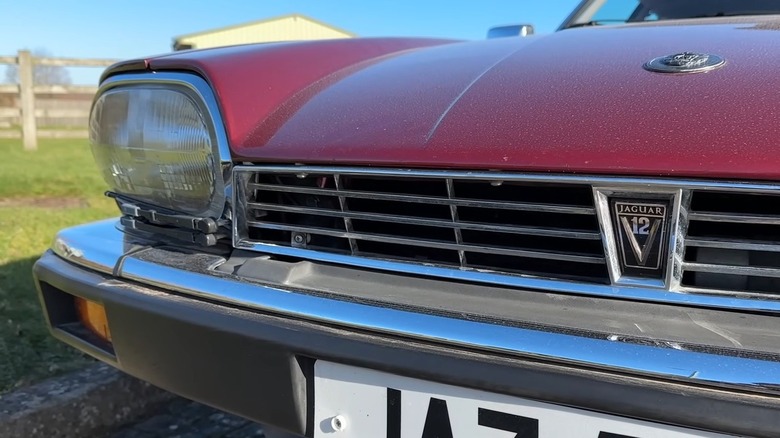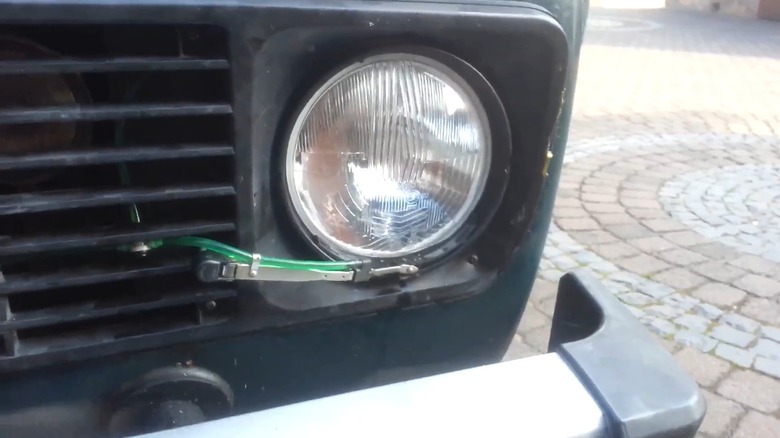5 Of The Weirdest Cars With Headlight Wipers
From cars with pop-up headlights to ones with bubble canopies, automakers have never shied away from experimenting with weird car design concepts. You might be familiar with windshield wipers, but have you ever seen headlight wipers? They were actually quite common in the '80s and '90s, at least in Europe. Luxury brands including Mercedes, BMW, Volvo, and Saab offered several models with headlight wipers that worked just like windshield wipers.
The goal was simple: keeping headlights clear of dirt, snow, and grime to ensure perfect visibility. Cleaning was done with a push of a dedicated button, and it eliminated the need to pull the car over to the side of the road to clean it — indeed a luxury. Headlight wipers even came in different styles. Some moved from side to side, while others moved up and down. The FSO Polski Fiat 125p Lapponia even had a headlight wiper at the center, and had to turn 180 degrees to clean the headlights.
Headlight wipers did not last long, as they were prone to damage, and replacing them meant extra cost. Modern cars now employ modern solutions, such as headlight washers or self-cleaning coatings. Still, cars with headlight wipers remain curious reminders of the experiments automakers have done in the past.
Let's take a look at five of the weirdest cars with headlight wipers that were short-lived but etched a name in history.
Saab 99
Swedish auto brand Saab Automobile was founded in 1945, and introduced its first car, the Saab 92, in 1949. However, the Saab 99, launched in the 1970 model year, is more meaningful for our purposes, as it was the first car to ever feature headlight wipers. The Saab 99 was also loaded with other features, such as shock-absorbing bumpers, side impact protection, electrically heated seats, and a turbo engine, but the headlight wipers were the standouts.
The car was so admired by experts that, in its 1968 review, Mass Motorist magazine praised the car for giving "the flavour of an aeroplane on four wheels." Saab used a linear approach for its headlight wipers, rather the typical angular approach like conventional wipers. The system was promoted as a safety feature, and interestingly, the Swedish government made it a mandatory feature for vehicles in the country two years later.
Upon pressing the button, a little wiper came out from the side, and it cleaned the rectangular headlights using the water thrown by the washer. Saab also introduced an up-and-down moving headlight wiper system in its cars. Saab was also awarded the 1971 Gold Medal of the Swedish Automobile Association for equipping all of its cars with a headlight wiper and washer system. Saab retired the Saab 99 in 1984, replacing it with the Saab 90 and the Saab 900.
Volvo 240
While Volvo has now become more of an SUV brand, it produced some great station wagons and sedans back in the day, and this list wouldn't be complete without mentioning the Volvo 240. The model was introduced in 1974 and was quite popular because of its angular and boxy design, which allowed for crumple zones and large bumpers to absorb collisions. Fun fact: As per a report by the Insurance Institute for Highway Safety in the U.S., the Volvo 240 had the lowest death rate of any car in the country.
Apart from featuring such great safety features, the Volvo 240 was also famous for its headlight wiper system. Volvo was second to Saab in introducing this feature However, Volvo's implementation of the headlight wiper system was a bit different: the blades were quite big, and worked exactly how the windshield wipers worked, from down to up.
The Volvo 240, specifically the Volvo 240 Turbo Wagon featuring a 2.1-liter turbocharged engine, was the world's fastest wagon, winning the Group A racing in Europe. Volvo produced the 240 series — available as a station wagon and sedan — from 1974 to 1993, and during its 19-year run, a total of 2.9 million units came out of the factory.
BMW E30 3-Series
The BMW E30 3-series has to be the weirdest car with headlight wipers, not because of its looks, but because of how the headlight wipers worked. Considered one of the best BMWs ever built, this highly collectible car had a build quality that was top-notch, performed exceptionally well (the M3 variant made it more exciting), and had looks that stood out from the crowd.
The E30 3-series was launched in multiple variants, including a four-door sedan, estate wagon, or a high-performance M3 model. It was also the first BMW series to come fitted with all-wheel drive and a diesel engine. Since the car had four circular headlights, the company used a straight arm on a fixed pivot with flexible rubber wipers, with water dripping from the top. As a result, the headlight wipers were able to effectively clean the lights.
Notably, the headlight wipers were an optional feature and were available on the higher-spec'd variant of the BMW E30 3-Series. The model was produced from 1982 to 1994, and a total of a little over 2.3 million units were made. It was a big part of how the 3-Series becoming BMW's best-selling line worldwide. Fun fact: This wasn't the only BMW car with headlight wipers — the 1980 BMW E23 735i also featured four headlight wipers and quad-circular headlights.
Jaguar XJ-S
These days, Jaguar and Land Rover are owned by India's Tata Motors, but the brands have a long history of producing luxury cars. One of the luxury models of the past, the Jaguar XJ-S, made between 1975 and 1996, was an aerodynamic car of its era. It could accelerate to 60 mph in 7.6 seconds and achieve a top speed of 143 mph. The Jaguar XJ-S was powered by a 5.3-liter V12 high-efficiency engine, which gave the fuel economy a boost of 50% compared to the XK-E. While the XJ-S was a loaded car, its launch during the 1976 fuel crisis dented its sales figures, and the car experienced lackluster sales.
But that didn't stop the car from being iconic. The Jaguar XJ-S featured headlight wipers for its pretty awkward-looking headlights. The best part about XJ-S's headlight wipers was that Jaguar didn't just follow others in offering a feature; it put some brains behind its implementation. Jaguar fitted the XJ-S with "Pantograph" headlight wipers, more commonly seen on buses, boats, or RVs. The same wiper system was also used in the window of the Porsche 928, one the brand's most underrated cars.
A wiper blade was fitted on an arm that would move perpendicularly up and down the headlight to clean it. Interestingly, Jaguar offered the headlight wiper system on its XJ-S that was sold in Europe, Canada, and Australia, and not on the American models, which featured round headlights.
Lada Niva
Although Volvo continued to offer cars with a headlight wiper in its S60 sedan, and Range Rover continued with the L322 generation, there was one weird car from the USSR, which symbolized national pride: the Lada Niva. It was the year 1966 when the Soviet government partnered with Italian car manufacturer Fiat to produce Lada. It was based on the Fiat 124, but came with tweaked suspension, a durable body, extra rust protection, and the engineers simplified the engine so that it could be easily repaired.
Thanks to its affordability, compact size, and being easily reparable, the Lada was an instant success, and millions of units of this car were sold. However, the government wanted a more rugged vehicle, the result of which was the Lada Niva, based on the Fiat 127. Producing 76 hp and 93 lb-ft of torque, the Lada Niva also came with circular headlights and a headlight wiper system.
AvtoVAZ, the company that produced the Lada Niva, used the same concept as the BMW E30 3-Series for its headlight wiper system. A fixed arm attached with a rubber wiper moving back and forth. The Lada Niva has been in production since 1977, and it continues to remain the same — a cool foreign off-roader.
